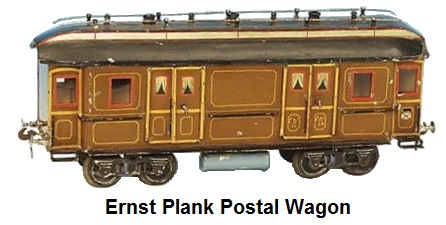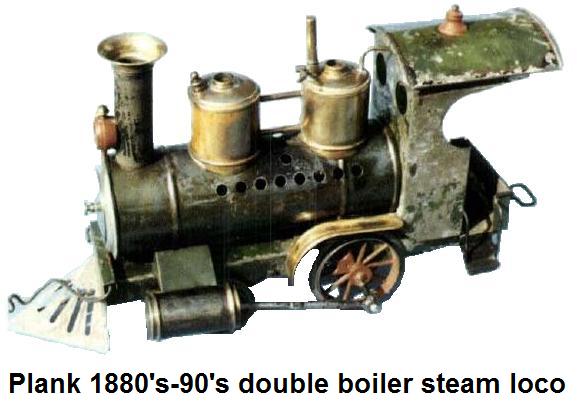 Ernst Plank & Company started out in 1866 in Nüremberg Germany as a toy-repair shop (Fabrik Optischer und Merchandiser Waren).
Named after the company founder, they made magic lanterns, steam engines, die cast metal planes, boats, cars, carriages, water
fountains, steamboats, sewing machines and model trains produced from pressed tin plate. They also produced models of shop
equipment, like drill presses and sanders, as well as carnival toys and objects, such as ferris wheels and chair rides, that
operated off of drive belts powered by the spirit-fired stationary steam engines. At one point in time the company was the
second largest manufacturer of magic lanterns. They also produced animated toys that were operated not only by steam power,
but also via hot air power, and spring/clockwork mechanisms.
Ernst Plank & Company started out in 1866 in Nüremberg Germany as a toy-repair shop (Fabrik Optischer und Merchandiser Waren).
Named after the company founder, they made magic lanterns, steam engines, die cast metal planes, boats, cars, carriages, water
fountains, steamboats, sewing machines and model trains produced from pressed tin plate. They also produced models of shop
equipment, like drill presses and sanders, as well as carnival toys and objects, such as ferris wheels and chair rides, that
operated off of drive belts powered by the spirit-fired stationary steam engines. At one point in time the company was the
second largest manufacturer of magic lanterns. They also produced animated toys that were operated not only by steam power,
but also via hot air power, and spring/clockwork mechanisms.
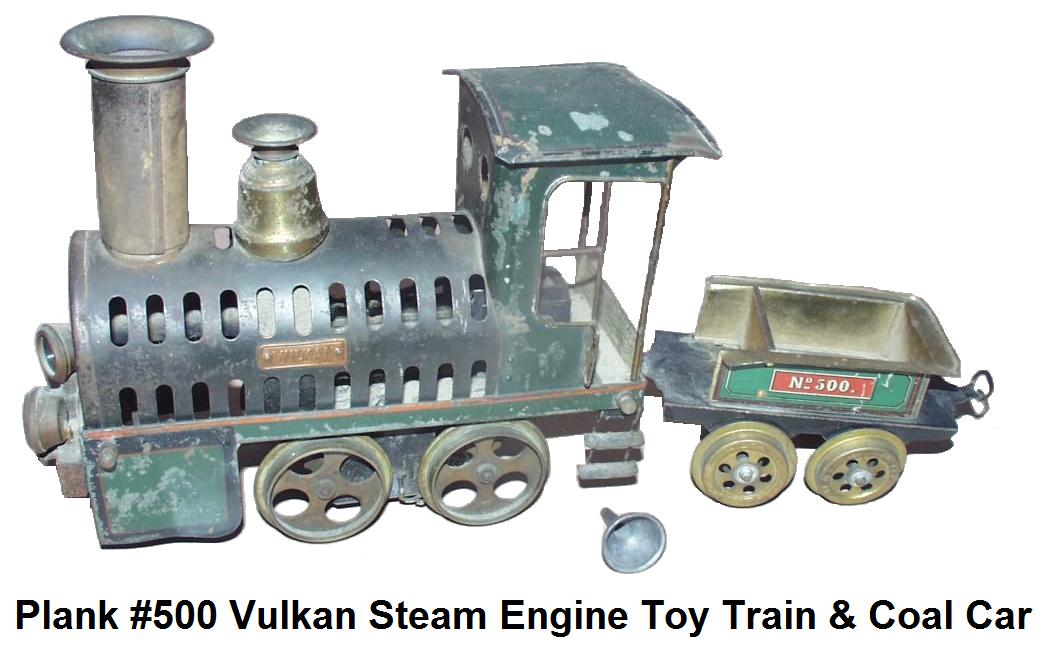 |
 |
The company was located at Hochfederstrasse 40 in Nüremberg. Plank's toys were notable for their
quality, often being ornate in design and more finely finished than other manufacturers of that era. Ernst Plank is often
credited with being one of the original inventors of the magic lantern and the stationary steam engine model and was deemed to
be one of the most aggressive competitors of the Brothers Bing. Little is known
about the background of Ernst Plank, except that he was trained as a tinsmith and passed examinations to be certified as a
master tinsmith (Flaschnermeister). Plank is recognized for his improvement of the Agand wick that he invented and
devloped to achieve an exceptional concentration of light in the magic lanterns he produced. In addition to having
its own sales organization, the company also sold its products through well known retailers from Nüremberg-Fürth.
A.W. Gamage, London, was the UK distributor for Ernst Plank toys and models.

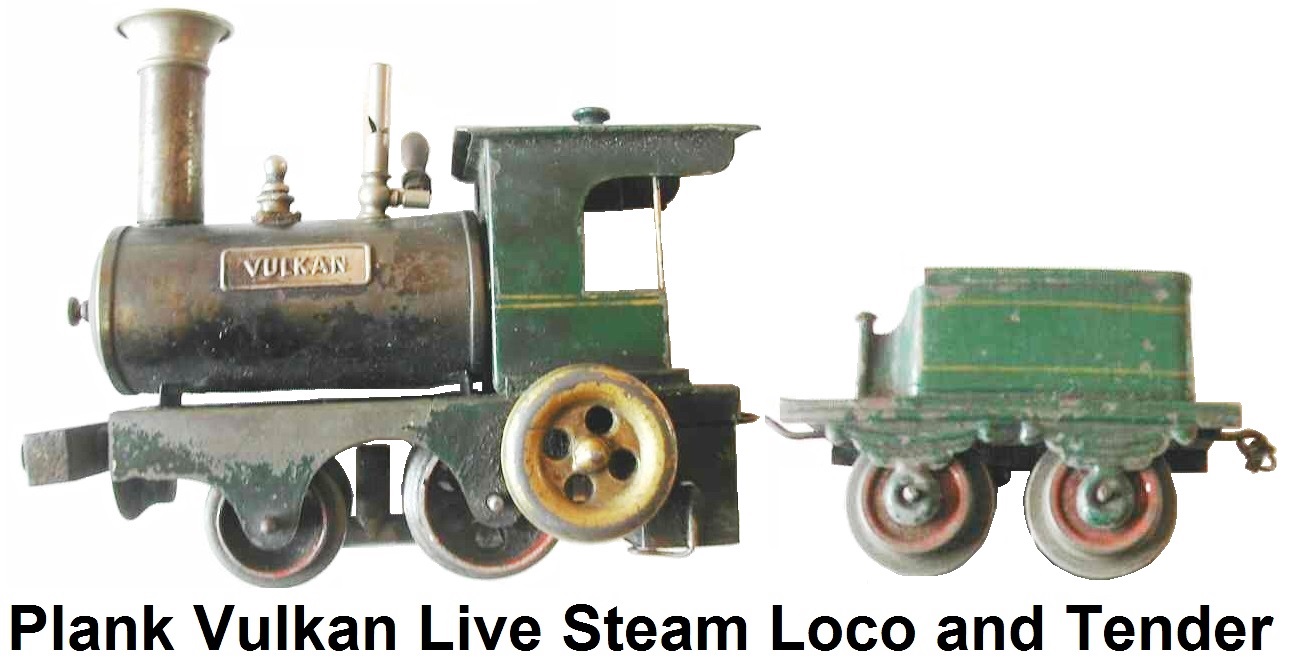 Plank produced it's first toy train in 1882. The early trains made through 1885 were gauge III (2½ inch track gauge) and
were marketed as complete sets that included a steam powered Ernst Plank 0-4-0 Vulcan locomotive, four-wheel lithographed
rolling stock with pressed brass wheels, and a circle of track. The locomotive had a single-acting oscillating cylinder
and a single-stage reduction gear. Spur gears were also used by Plank. Track was made of tinplate, and came in sections that
were put together and held in place with steel pins, just like the tinplate track sections manufactured in modern times. Many
of the trains were hand enameled and contained a high level of detail. Early passenger coaches did not have punched out
windows but instead featured curtains and passengers painted in the windows. Plank also produced a 0-6-0 version of the
Vulcan live-steam driven locomotive in gauge III. This locomotive featured a flywheel to the left side of the cab and
a gear drive to the rear axle.
Plank produced it's first toy train in 1882. The early trains made through 1885 were gauge III (2½ inch track gauge) and
were marketed as complete sets that included a steam powered Ernst Plank 0-4-0 Vulcan locomotive, four-wheel lithographed
rolling stock with pressed brass wheels, and a circle of track. The locomotive had a single-acting oscillating cylinder
and a single-stage reduction gear. Spur gears were also used by Plank. Track was made of tinplate, and came in sections that
were put together and held in place with steel pins, just like the tinplate track sections manufactured in modern times. Many
of the trains were hand enameled and contained a high level of detail. Early passenger coaches did not have punched out
windows but instead featured curtains and passengers painted in the windows. Plank also produced a 0-6-0 version of the
Vulcan live-steam driven locomotive in gauge III. This locomotive featured a flywheel to the left side of the cab and
a gear drive to the rear axle.
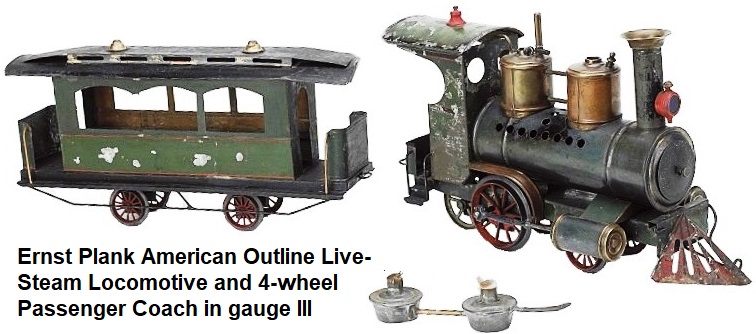 American-profile trains were made expressly for export to the the U.S. market. These engines were fitted
with cow-catchers. A typical live steam gauge III locomotive featured 2 vertical copper boilers housed in a dummy blued
boiler with ventilation holes. 1 boiler had a filler cap and the other had a wood handled lever that operated the whistle.
Power was transferred via a piston located in the engine cabin to a bottom mounted flywheel and through a complex gear box to
the rear wheels. The 2-pot burner was inserted through the dummy boiler front. Copper accents on the engine included fenders,
steam chest caps and a stack flare. The pilot was typically painted red with black striping. The 4-wheel passenger coaches had
interior bench seats with spikes for mounting passenger figures. An embossed oval tin maker's plate was normally placed on the
boiler front.
American-profile trains were made expressly for export to the the U.S. market. These engines were fitted
with cow-catchers. A typical live steam gauge III locomotive featured 2 vertical copper boilers housed in a dummy blued
boiler with ventilation holes. 1 boiler had a filler cap and the other had a wood handled lever that operated the whistle.
Power was transferred via a piston located in the engine cabin to a bottom mounted flywheel and through a complex gear box to
the rear wheels. The 2-pot burner was inserted through the dummy boiler front. Copper accents on the engine included fenders,
steam chest caps and a stack flare. The pilot was typically painted red with black striping. The 4-wheel passenger coaches had
interior bench seats with spikes for mounting passenger figures. An embossed oval tin maker's plate was normally placed on the
boiler front.

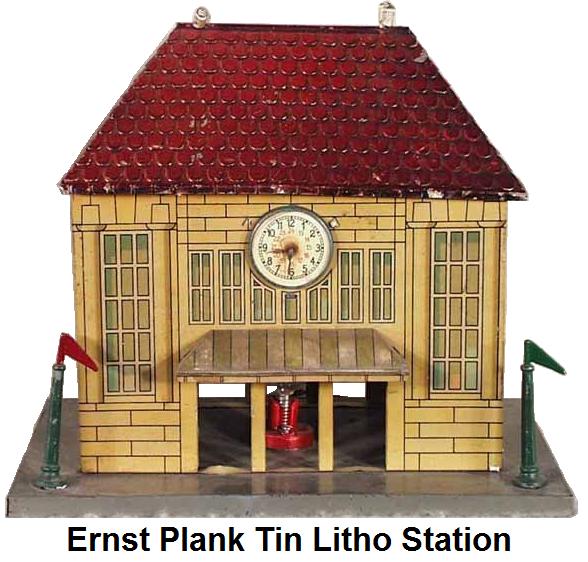 In 1894 Plank was employing 120 workers at its factory. Production numbers from the turn of the century indicate that Plank
was producing 80,000 steam engines and locomotives, and about 150,000 magic lanterns each year.
By 1900 Plank's catalogs displayed a huge array of electro-physics gadgets and a full
spectrum of optical devices, toy boats, stationary steam engines, and locomotives. The catalogs were richly illustrated
as almost every apparatus was accompanied by a detailed engraving. Even a steam turbine locomotive
was offered. Some of the trains were designed to run on track, while others were for floor operation. The front
wheels usually had very thin flanges on the track runner models, and could be turned and locked, so that
a circle radius could be run on the floor, without the use of track. Track gauge was 2½", but
the 'scale' was between 'O' and Standard. Plank dubbed its 65mm product as 8 gauge.
In 1894 Plank was employing 120 workers at its factory. Production numbers from the turn of the century indicate that Plank
was producing 80,000 steam engines and locomotives, and about 150,000 magic lanterns each year.
By 1900 Plank's catalogs displayed a huge array of electro-physics gadgets and a full
spectrum of optical devices, toy boats, stationary steam engines, and locomotives. The catalogs were richly illustrated
as almost every apparatus was accompanied by a detailed engraving. Even a steam turbine locomotive
was offered. Some of the trains were designed to run on track, while others were for floor operation. The front
wheels usually had very thin flanges on the track runner models, and could be turned and locked, so that
a circle radius could be run on the floor, without the use of track. Track gauge was 2½", but
the 'scale' was between 'O' and Standard. Plank dubbed its 65mm product as 8 gauge.
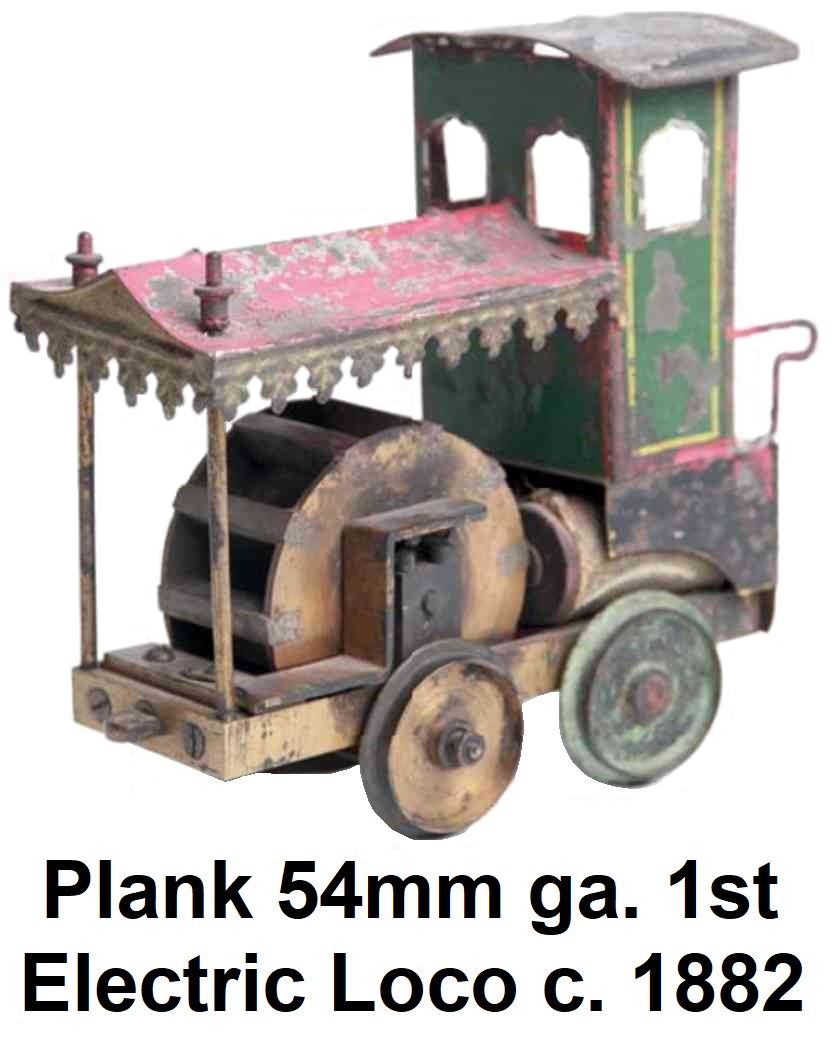 Eight major manufacturers of model steam engines conducted
business in the Nüremburg area: Bing, Carette, Doll,
Falk, Krauss Mohr, Märklin, Plank and Schöenner. Along with
firms like these, Ernst Plank set the standard for the Golden Age of European toy manufacturing. Of all of the Nüremburg
makers, Plank probably made the most diverse and elegant models. Plank equipment is
easily identified by the trademark embossing that had the letters 'EP' inside a cirlce surrounded by a winged wheel.
Plank amazed the toy world in 1882 by introducing Germany's first electric train. They are famous for their so-called
"stork-engines". Their "Black Prince" is one of the most wanted live steam trains for collectors.
Eight major manufacturers of model steam engines conducted
business in the Nüremburg area: Bing, Carette, Doll,
Falk, Krauss Mohr, Märklin, Plank and Schöenner. Along with
firms like these, Ernst Plank set the standard for the Golden Age of European toy manufacturing. Of all of the Nüremburg
makers, Plank probably made the most diverse and elegant models. Plank equipment is
easily identified by the trademark embossing that had the letters 'EP' inside a cirlce surrounded by a winged wheel.
Plank amazed the toy world in 1882 by introducing Germany's first electric train. They are famous for their so-called
"stork-engines". Their "Black Prince" is one of the most wanted live steam trains for collectors.
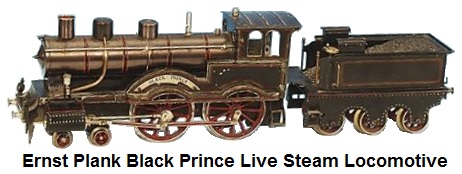
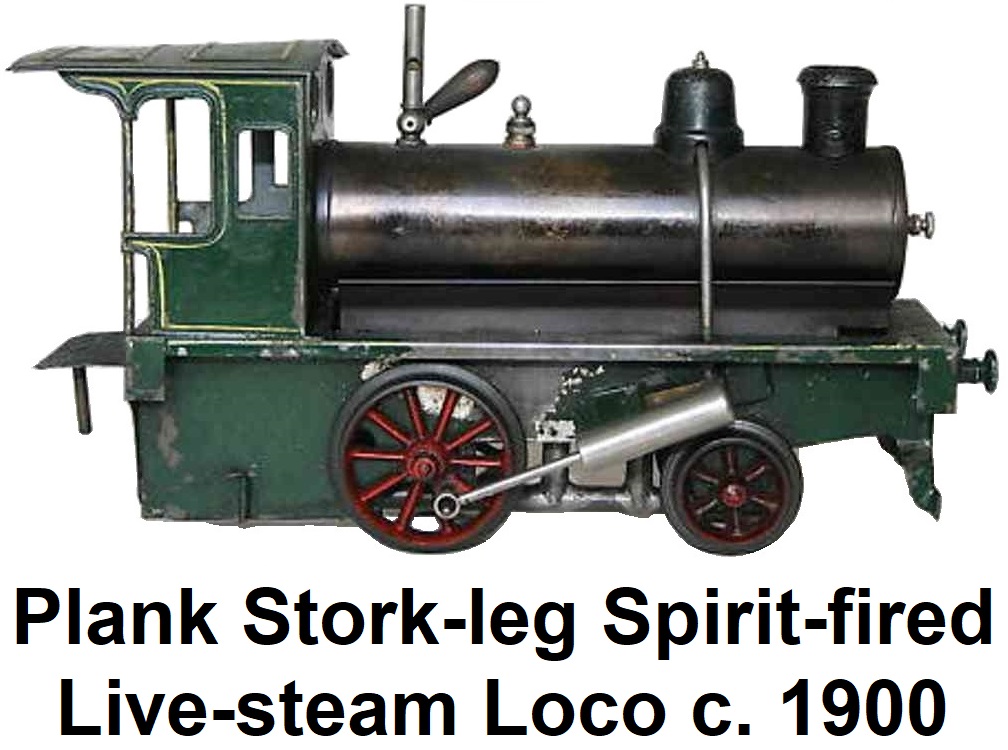 The company also produced clockwork powered tinplate trains and some hot-air engine driven trains. Plank's patented hot-air
engine used the expansion of heated air to drive a small piston. This is a similar concept to a spirit-fired live-steam engine
that uses pressure generated from expanding heated water vapor to drive a piston through a cylinder. Little is known about
Plank's decision to explore this hot-air method, but it did omit the need for a heavy water boiler, making the toy lighter and
possibly faster than the competition. The era of hot-air engines was short lived however, and only two Plank locomotive models
were known to have employed these engines. Plank catalogues proudly mentioned the gold
medals awarded to them at the Paris International Exhibition of 1900 and the 1906 Bavarian Trades Show. In the early
The company also produced clockwork powered tinplate trains and some hot-air engine driven trains. Plank's patented hot-air
engine used the expansion of heated air to drive a small piston. This is a similar concept to a spirit-fired live-steam engine
that uses pressure generated from expanding heated water vapor to drive a piston through a cylinder. Little is known about
Plank's decision to explore this hot-air method, but it did omit the need for a heavy water boiler, making the toy lighter and
possibly faster than the competition. The era of hot-air engines was short lived however, and only two Plank locomotive models
were known to have employed these engines. Plank catalogues proudly mentioned the gold
medals awarded to them at the Paris International Exhibition of 1900 and the 1906 Bavarian Trades Show. In the early
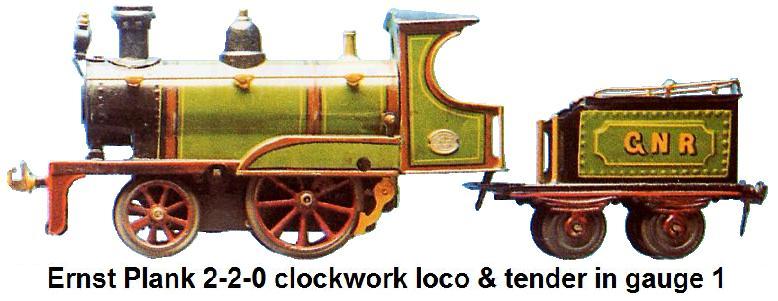 1900's Plank was known to have been a sub-contractor to Märklin for some of its tinplate toys.
Plank survived the First World War, however, the company was one of the many firms that suffered from the 1929 depression and
economic crisis. The company was sold in 1932 to brothers Hans and Fritz Schaller, who bought the factory largely to get the
optics from Plank's magic lantern line. Schaller specialized in home movie equipment. Schaller became Noris Projecktor after
WW2, and remained in business until 1965. Some Noris-produced film splicing tools, circa 1950's/1960's vintage, have
shown up labeled Ernst Plank, so it would appear that Schaller kept the name alive for some time.
1900's Plank was known to have been a sub-contractor to Märklin for some of its tinplate toys.
Plank survived the First World War, however, the company was one of the many firms that suffered from the 1929 depression and
economic crisis. The company was sold in 1932 to brothers Hans and Fritz Schaller, who bought the factory largely to get the
optics from Plank's magic lantern line. Schaller specialized in home movie equipment. Schaller became Noris Projecktor after
WW2, and remained in business until 1965. Some Noris-produced film splicing tools, circa 1950's/1960's vintage, have
shown up labeled Ernst Plank, so it would appear that Schaller kept the name alive for some time.
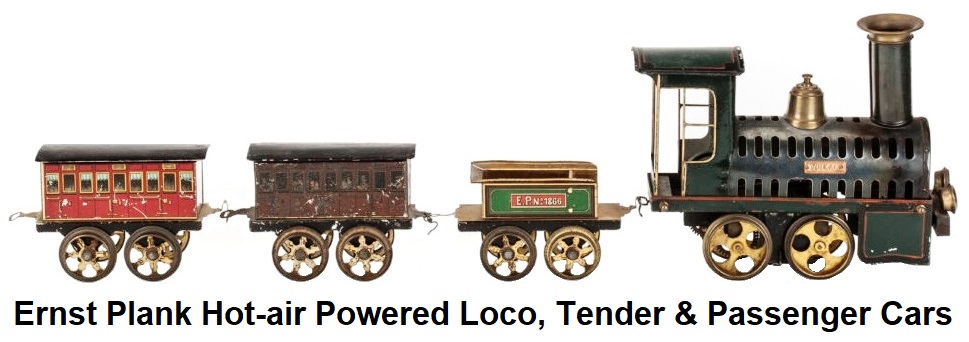
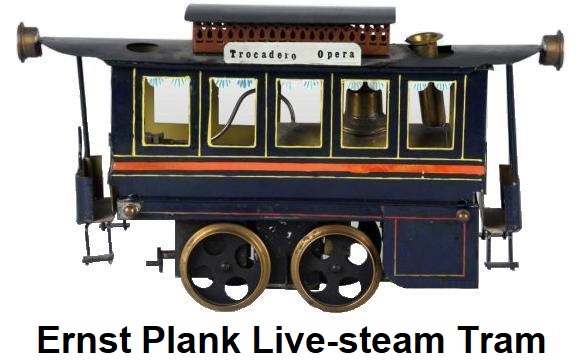 Today, Plank trains are very rare and highly collectible. Few models have survived, and some items are known to exist only in
single digit quantities. Another reason that these trains are so rare is that the production process was not standardized,
nor was there any kind of quality control or a 20th century style assembly line during the periods of production. Products
were assembled using whatever parts were on-hand on that given day. As production on an item progressed over time, the model's
design was typically modified and improved, therefore multiple variants of a single model are commonly found, when these
trains are actually discovered. A rare Ernst Plank gauge III live steam passenger train set with a locomotive, tender and two
Today, Plank trains are very rare and highly collectible. Few models have survived, and some items are known to exist only in
single digit quantities. Another reason that these trains are so rare is that the production process was not standardized,
nor was there any kind of quality control or a 20th century style assembly line during the periods of production. Products
were assembled using whatever parts were on-hand on that given day. As production on an item progressed over time, the model's
design was typically modified and improved, therefore multiple variants of a single model are commonly found, when these
trains are actually discovered. A rare Ernst Plank gauge III live steam passenger train set with a locomotive, tender and two
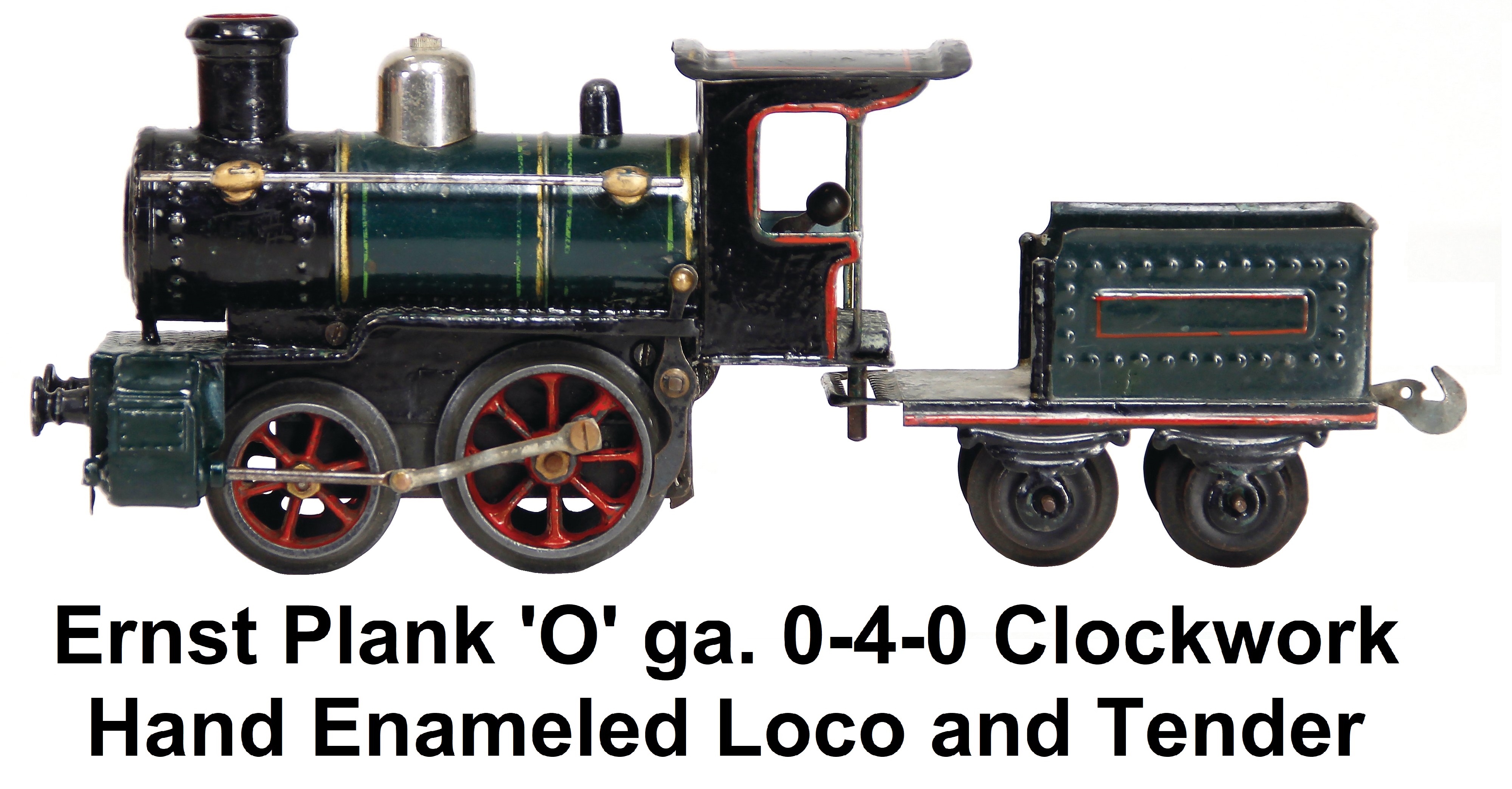 passenger cars and a circle track in its original wooden presentation box, from the collection of Ward Kimball brought $46,750
at a June 2005 auction. A very rare Ernst Plank live-steam driven tram sold for $10,925 at Morphy's Auctions in December
of 2009. Also in 2009, Selzer Auctions in Germany sold a model of the Ernst Plank electric locomotive from 1882 for
€6,450 ($7,643). In the 1970's the well known Hobby Haas company of Frankfurt Germany commissioned the Firm Jan Blenken
of Nüremberg to manufacture a reproduction Ernst Plank 1 gauge live-steam train set. This set is also quite scarce as it was
part of a limited production run. It consisted of an 0-4-0 Vulcan type loco with cab mounted oscillating cylinder, a tender
and 3 hand enamelled 4-wheel tinplate cars. It was produced for both the German and English markets.
passenger cars and a circle track in its original wooden presentation box, from the collection of Ward Kimball brought $46,750
at a June 2005 auction. A very rare Ernst Plank live-steam driven tram sold for $10,925 at Morphy's Auctions in December
of 2009. Also in 2009, Selzer Auctions in Germany sold a model of the Ernst Plank electric locomotive from 1882 for
€6,450 ($7,643). In the 1970's the well known Hobby Haas company of Frankfurt Germany commissioned the Firm Jan Blenken
of Nüremberg to manufacture a reproduction Ernst Plank 1 gauge live-steam train set. This set is also quite scarce as it was
part of a limited production run. It consisted of an 0-4-0 Vulcan type loco with cab mounted oscillating cylinder, a tender
and 3 hand enamelled 4-wheel tinplate cars. It was produced for both the German and English markets.





